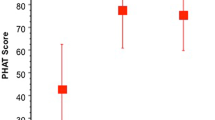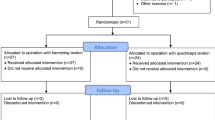Abstract
Purpose
To report outcomes following proximal hamstring reconstruction employing an ipsilateral distal hamstring tendon autograft, in patients with chronic proximal ruptures.
Methods
Six patients presenting with a chronic proximal hamstring avulsion and a medial time from injury of 11.0 months (range 7–18), confirmed via magnetic resonance imaging, underwent proximal hamstring repair using a free graft harvested from the ipsilateral distal hamstrings. Patients were evaluated at 6, 12 and 24 months post-surgery, via the Perth Hamstring Assessment Tool, the Short Form Health Survey, the Lower Extremity Functional Scale, a Patient Satisfaction Questionnaire, the Active Knee Extension and 6 min walk tests, the single and triple hop tests for distance, and isokinetic knee extensor and flexor strength. Knee strength was assessed at 180° and 240°/s (total work, peak and average torque), and both mean absolute scores and limb symmetry indices (LSIs) comparing the operated and non-operated limbs were presented.
Results
Patients demonstrated good clinical improvement throughout the post-operative timeline in all subjective and objective outcomes. Mean knee extensor LSIs had recovered by 12 and 24 months. At 24 months post-surgery, while mean LSIs for knee flexor peak and average torque were at (or above) 90%, a significant difference still existed between the operated and non-operated limbs in knee flexor total work. At 24 months, five patients (83%) were satisfied with the results of the surgery, as well as their ability to return to recreational and sporting activities. There were two adverse events including an early deep vein thrombosis and a secondary surgery to remove a loosened staple.
Conclusions
While isokinetic hamstring strength had not fully recovered by 24 months, this surgical technique demonstrated a high level of patient satisfaction and return to function, in patients with chronic proximal hamstring ruptures. As the clinical relevance, this surgical technique provides a viable option with good post-operative outcomes for patients with chronic proximal hamstring tears that cannot be approximated back to the ischium.
Level of evidence
IV.




Similar content being viewed by others
References
Binkley JM, Stratford PW, Lott SA, Riddle DL (1999) The Lower Extremity Functional Scale (LEFS): scale development, measurement properties, and clinical application. N Am Orthop Rehabil Res Netw Phys Ther 79:371–383
Birmingham P, Muller M, Wickiewicz T, Cavanaugh J, Rodeo S, Warren R (2011) Functional outcome after repair of proximal hamstring avulsions. J Bone Joint Surg Am 93:1819–1826
Blakeney WG, Zilko SR, Edmonston SJ, Schupp NE, Annear PT (2017) A prospective evaluation of proximal hamstring tendon avulsions: improved functional outcomes following surgical repair. Knee Surg Sports Traumatol Arthrosc 25:1943–1950
Blakeney WG, Zilko SR, Edmonston SJ, Schupp NE, Annear PT (2017) Proximal hamstring tendon avulsion surgery: evaluation of the Perth Hamstring Assessment Tool. Knee Surg Sports Traumatol Arthrosc 25:1936–1942
Bodendorfer BM, Curley AJ, Kotler JA, Ryan JM, Jejurikar NS, Kumar A, Postma WF (2018) Outcomes after operative and nonoperative treatment of proximal hamstring avulsions: a systematic review and meta-analysis. Am J Sports Med 46:2798–2808
Chahal J, Bush-Joseph CA, Chow A, Zelazny A, Mather RC III, Lin EC, Gupta D, Verma NN (2012) Clinical and magnetic resonance imaging outcomes after surgical repair of complete proximal hamstring ruptures: does the tendon heal? Am J Sports Med 40:2325–2330
Cohen SB, Rangavajjula A, Vyas D, Bradley JP (2012) Functional results and outcomes after repair of proximal hamstring avulsions. Am J Sports Med 40:2092–2098
Enright PL (2003) The six-minute walk test. Respir Care 48:783–785
Folsom GJ, Larson CM (2008) Surgical treatment of acute versus chronic complete proximal hamstring ruptures: results of a new allograft technique for chronic reconstructions. Am J Sports Med 36:104–109
Gajdosik R, Lusin G (1983) Hamstring muscle tightness. Reliability of an active-knee-extension test. Phys Ther 63:1085–1090
Guanche CA (2015) Hamstring injuries. J Hip Preserv Surg 2:116–122
Harris JD, Griesser MJ, Best TM, Ellis TJ (2011) Treatment of proximal hamstring ruptures—a systematic review. Int J Sports Med 32:490–495
Koulouris G, Connell D (2003) Evaluation of the hamstring muscle complex following acute injury. Skeletal Radiol 32:582–589
Kuske B, Hamilton DF, Pattle SB, Simpson AH (2016) Patterns of hamstring muscle tears in the general population: a systematic review. PLoS One 11:e0152855
Lempainen L, Sarimo J, Orava S (2007) Recurrent and chronic complete ruptures of the proximal origin of the hamstring muscles repaired with fascia lata autograft augmentation. Arthroscopy 23:441.e441–441.e445
Marx RG, Fives G, Chu SK, Daluiski A, Wolfe SW (2009) Allograft reconstruction for symptomatic chronic complete proximal hamstring tendon avulsion. Knee Surg Sports Traumatol Arthrosc 17:19–23
Mehta SP, Fulton A, Quach C, Thistle M, Toledo C, Evans NA (2016) Measurement properties of the Lower Extremity Functional Scale: a systematic review. J Orthop Sports Phys Ther 46:200–216
Moatshe G, Chahla J, Vap AR, Ferrari M, Sanchez G, Mitchell JJ, LaPrade RF (2017) Repair of proximal hamstring tears: a surgical technique. Arthrosc Tech 6:e311–e317
Muellner T, Kumar S, Singla A (2017) Proximal hamstring reconstruction using semitendinosus and gracilis autograft: a novel technique. Knee Surg Sports Traumatol Arthrosc 25:112–114
Murray PJ, Lowe WR (2009) Achilles allograft reconstruction of a chronic complete proximal hamstring rupture. Knee Surg Sports Traumatol Arthrosc 17:1360–1363
Noyes FR, Barber SD, Mangine RE (1991) Abnormal lower limb symmetry determined by function hop tests after anterior cruciate ligament rupture. Am J Sports Med 19:513–518
Orava S, Kujala UM (1995) Rupture of the ischial origin of the hamstring muscles. Am J Sports Med 23:702–705
Reid A, Birmingham TB, Stratford PW, Alcock GK, Giffin JR (2007) Hop testing provides a reliable and valid outcome measure during rehabilitation after anterior cruciate ligament reconstruction. Phys Ther 87:337–349
Rust DA, Giveans MR, Stone RM, Samuelson KM, Larson CM (2014) Functional outcomes and return to sports after acute repair, chronic repair, and allograft reconstruction for proximal hamstring ruptures. Am J Sports Med 42:1377–1383
Sarimo J, Lempainen L, Mattila K, Orava S (2008) Complete proximal hamstring avulsions: a series of 41 patients with operative treatment. Am J Sports Med 36:1110–1115
Skaara HE, Moksnes H, Frihagen F, Stuge B (2013) Self-reported and performance-based functional outcomes after surgical repair of proximal hamstring avulsions. Am J Sports Med 41:2577–2584
Subbu R, Benjamin-Laing H, Haddad F (2015) Timing of surgery for complete proximal hamstring avulsion injuries: successful clinical outcomes at 6 weeks, 6 months, and after 6 months of injury. Am J Sports Med 43:385–391
Thomsen NO, Jensen TT (1999) Late repair of rupture of the hamstring tendons from the ischial tuberosity—a case report. Acta Orthop Scand 70:89–91
Wood DG, Packham I, Trikha SP, Linklater J (2008) Avulsion of the proximal hamstring origin. J Bone Joint Surg Am 90:2365–2374
Funding
No external funding was used.
Author information
Authors and Affiliations
Corresponding author
Ethics declarations
Conflict of interest
All authors declare no individual conflicts.
Ethical approval
Ethics approval was obtained by the Hollywood Private Hospital (HPH432) and the University of Western Australia (RA/4/1/8829).
Rights and permissions
About this article
Cite this article
Ebert, J.R., Gormack, N. & Annear, P.T. Reconstruction of chronic proximal hamstring avulsion injuries using ipsilateral distal hamstring tendons results in good clinical outcomes and patient satisfaction. Knee Surg Sports Traumatol Arthrosc 27, 2958–2966 (2019). https://doi.org/10.1007/s00167-018-5310-y
Received:
Accepted:
Published:
Issue Date:
DOI: https://doi.org/10.1007/s00167-018-5310-y




